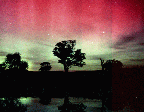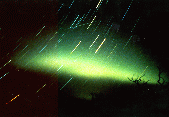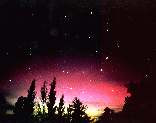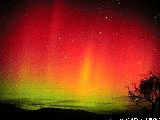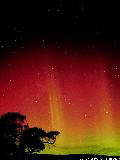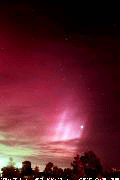Aurora Photos and the Aurora Explained
The Aurora is a spectacular natural phenomenon occurring in the Earth's upper atmosphere, associated with powerful emissions from the Sun and geomagnetic disturbances. They are seen mostly at high or polar latitudes but, occasionally may be seen at middle latitudes when a really large solar event occurs. For example, during a huge disturbance in March 1989, there were auroras seen over northern Australia in Exmouth (WA) and in the northern hemisphere, as far south as Texas.
Auroras are caused by high energy charged particles from the Sun, such as electrons, entering the magnetosphere of the Earth. This is most likely to happen during a geomagnetic storm, resulting from the bombardment of the Earth by solar particles following a Coronal Mass Ejection (CME). A CME often causes a major geomagnetic disturbance or "storm" which creates an opening for energetic particles streaming from the Sun to enter the Earth's magnetosphere. In the wake of the CME impacting the Earth, in addition to the geomagnetic storm, the speed and density of the solar wind, the flow of particles outward from the Sun, is particularly high, enhancing the effect further. Once within the magnetosphere, the solar particles interact with the Earth's magnetic field, spiralling around the field lines and following them towards the poles. Since the geomagnetic field lines converge toward the poles, the enegetic particles also converge towards the poles and are also drawn downward into the ionosphere. In the ionosphere, they strike molecules and atoms of air at around 100 kilometres from the Earth's surface (eg, nitrogen and oxygen) causing them to radiate light. This light creates the beautiful colours of the aurora!
The structure of the aurora can be as rich and varied as clouds and as beautiful as a rainbow. The chemical composition of the ionosphere varies greatly with altitude and hence so do the colours produced by the incoming solar particles. When viewed from a large distance away as is often the case (say, many thousands of kilometres equatorward) this means that the aurora can vary in colour from the horizon up into the sky. The Earth's magnetic field is also experiencing constant small variations and changing patterns, causing variation in the speed and character of the incoming solar particles. Winds blow through the ionosphere where the light emitting atoms are, causing them to shift in waves and ripples. The richly structured auroral displays exhibit numerous shapes and forms such as bands, arcs, rays and sheets. No two auroral displays are alike and they may vary considerably in shape and brightness over timescales from seconds to minutes.
As with many spectacular natural sights, photos can never quite do them justice. The photos below however, give you some idea of the beauty and variety of aurora.
The series of photographs below were taken by David Miller and Craig Richardson.
The following photographs were taken by Didier Monselesan who was a staff member at SWS. They were taken from Casey Station (Antarctica) [66.28 South; 110.52 East] during the 1993 Austral winter, viewed towards the East-North-East for the first picture (pole and building) and West-South-West for the second (Met Domes). The film was 64 ASA Ektachrome; aperture F2.0; exposure of 30-45 seconds.
The Astronomical Society of South Australia website includes many nice aurora photographs from members.





